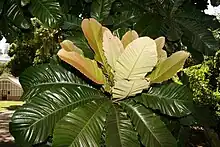Chrysophyllum imperiale
Chrysophyllum imperiale is a tropical tree of the family Sapotaceae native to eastern South America. It is currently classified as an endangered species.[1] Its fruits were very much appreciated by the first emperor of Brazil, Pedro I and his son Pedro II, who exported specimens of the tree as an offering to various botanical gardens around the world, including Sydney and Lisbon.[2]
| Chrysophyllum imperiale | |
|---|---|
 | |
| golden new growth, Royal Botanic Gardens, Sydney | |
| Scientific classification | |
| Kingdom: | Plantae |
| Clade: | Tracheophytes |
| Clade: | Angiosperms |
| Clade: | Eudicots |
| Clade: | Asterids |
| Order: | Ericales |
| Family: | Sapotaceae |
| Genus: | Chrysophyllum |
| Species: | C. imperiale |
| Binomial name | |
| Chrysophyllum imperiale | |
| Synonyms | |
|
Martusiella imperialis (Linden ex K. Koch & Fintelm.) Pierre | |
Distribution
It is endemic to the Atlantic Forest ecoregion of eastern Brazil, native to the vicinity of Rio de Janeiro. Most of its habitat has been erased by urbanisation and city spread.[3] It is a component of lowland rainforest up to 800 m (2,600 ft) elevation, where it grows to be a part of the canopy.[4]
Description
Chrysophyllum imperiale has large firm roundish cuneate-oblanceolate leaves, which measure 15 to 75 cm (6 to 29.5 in) long and 5–25 cm (2–10 in) wide. They are smooth above and finely furred on the undersurface, and have a prominent midrib.[5] The leaf margins are serrated, which is an unusual characteristic for the subfamily to which it belongs.[6]
Taxonomy
This species was first described in 1859 as Theophrastia imperialis, before being given its current name by Joseph Dalton Hooker and George Bentham. It was also classified as Martusiella imperialis by French botanist J.B. Louis Pierre in 1891. It is known locally in Brazil as Marmelleiro do matto.[5] In 1991 it was placed in section Aneuchrysophyllum of the genus Chrysophyllum, along with C. bangweolense and C. venezuelanense. However a combined DNA and morphological study of the subfamily Chrysophylloideae found the two main genera, Chrysophyllum and Pouteria, to be highly polyphyletic, and that C. imperiale is not closely related to other members of the genus but instead the genus Elaeoluma. The study authors recommend resurrecting the binomial name Martusiella imperialis pending further resolution of relationships within the subfamily.[6]
Cultivation
An imposing specimen tree in the Royal Botanic Gardens, Sydney was planted by Prince Alfred, Duke of Edinburgh in 1868.[7] Seeds from this plant have been sent to Rio de Janeiro to facilitate recovery of the species there.[3] Three specimens are growing in the Royal Botanic Gardens in Melbourne.[8]
It can be grown as a container plant.[3]
References
- Pires O'Brien, J. 1998. Chrysophyllum imperiale. The IUCN Red List of Threatened Species 1998. Downloaded on 18 September 2015.
- "Árvores de Lisboa". revistabica.com. Retrieved 17 March 2021.
- Coleby-Williams, Jerry (5 September 2003). "Fact Sheet: Grow Your Own Threatened Species". Gardening Australia website. Australian Broadcasting Corporation. Retrieved 11 January 2012.
- Rejan R. Guedes-Bruni and Haroldo C. de Lima. "Mountain Ranges of Rio de Janeiro". Centres of Plant Diversity: The Americas. Washington, D.C.: Department of Botany, National Museum of Natural History, Smithsonian Institution. Retrieved 12 January 2012.
- Cronquist, Arthur (1946). "Studies in the Sapotaceae-V. The South American Species of Chrysophyllum". Bulletin of the Torrey Botanical Club. 73 (3): 286–311. doi:10.2307/2481670. JSTOR 2481670.
- Swenson, Ulf; Richardson, James E.; Bartish, Igor V. (2008). "Multi-gene phylogeny of the pantropical subfamily Chrysophylloideae (Sapotaceae): Evidence of generic polyphyly and extensive morphological homoplasy". Cladistics. 24 (6): 1006–31. doi:10.1111/j.1096-0031.2008.00235.x. S2CID 85192293.
- "Tree Truths". Royal Botanic Gardens and Domain Trust. Sydney, New South Wales: New South Wales Government. Archived from the original on 23 June 2012. Retrieved 11 January 2012.
- Royal Botanic Gardens, Melbourne (11 January 2012). "Chrysophyllum imperiale at the Royal Botanic Gardens Melbourne". Royal Botanic Gardens, Melbourne Website. Royal Botanic Gardens Board Victoria. Retrieved 12 January 2012.
